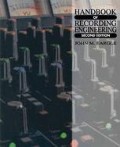Abstract
While popular and rock music is usually recorded (some would say created) in studios, most classical recording takes place in actual performance spaces, be they concert halls, ballrooms, or houses of worship. To the extent that a classical recording attempts to convey a sense of space or ambience appropriate for the music, it will be useful to analyze performance spaces in terms of direct, early, and reverberant fields. The direct field is of course the sound reaching the listener along a straight line from the source on stage. The early field generally describes the ensemble of early reflections from the front and sides of the space to the listener. The time interval usually discussed here is the first 100 msec after the initial onset of sound. The reverberant field has been discussed earlier, and it is the statistical ensemble of many reflections that arrive uniformly at the listener from all directions. The trade-offs inherent in concert hall design will be discussed, as will some numerical methods for rating concert hall performance.
Access this chapter
Tax calculation will be finalised at checkout
Purchases are for personal use only
Preview
Unable to display preview. Download preview PDF.
Bibliography
Y. Ando, Concert Hall Acoustics, Springer-Verlag, New York (1985).
M. Barron, “The Subjective Effects of First Reflections in Concert Halls—The Need for Lateral Reflections.” J. Sound and Vibration, vol. 15, pp. 475–494 (1971).
L. Beranek, Music, Acoustics & Architecture, Wiley, New York (1962).
L. Cremer, Principles and Applications of Room Acoustics, Applied Science Publishers, New York (1978).
J. Eargle, Music, Sound, & Technology, Van Nostrand Reinhold, New York (1990).
M. Forsyth, Buildings for Music, MIT Press, Cambridge, Mass. (1985).
H. Kuttruff, Room Acoustics, Applied Science Publishers, London (1979).
W. Reichardt, A. Alim and W. Schmidt, Applied Acoustics, vol. 7 (1974).
T. Schultz, “Acoustics of Concert Halls”, IEEE Spectrum, vol. 2, no. 6 (1965).
Rights and permissions
Copyright information
© 1992 Springer Science+Business Media New York
About this chapter
Cite this chapter
Eargle, J. (1992). Characteristics of Performance Spaces. In: Handbook of Recording Engineering. Springer, Boston, MA. https://doi.org/10.1007/978-1-4757-1129-5_3
Download citation
DOI: https://doi.org/10.1007/978-1-4757-1129-5_3
Publisher Name: Springer, Boston, MA
Print ISBN: 978-1-4757-1131-8
Online ISBN: 978-1-4757-1129-5
eBook Packages: Springer Book Archive

